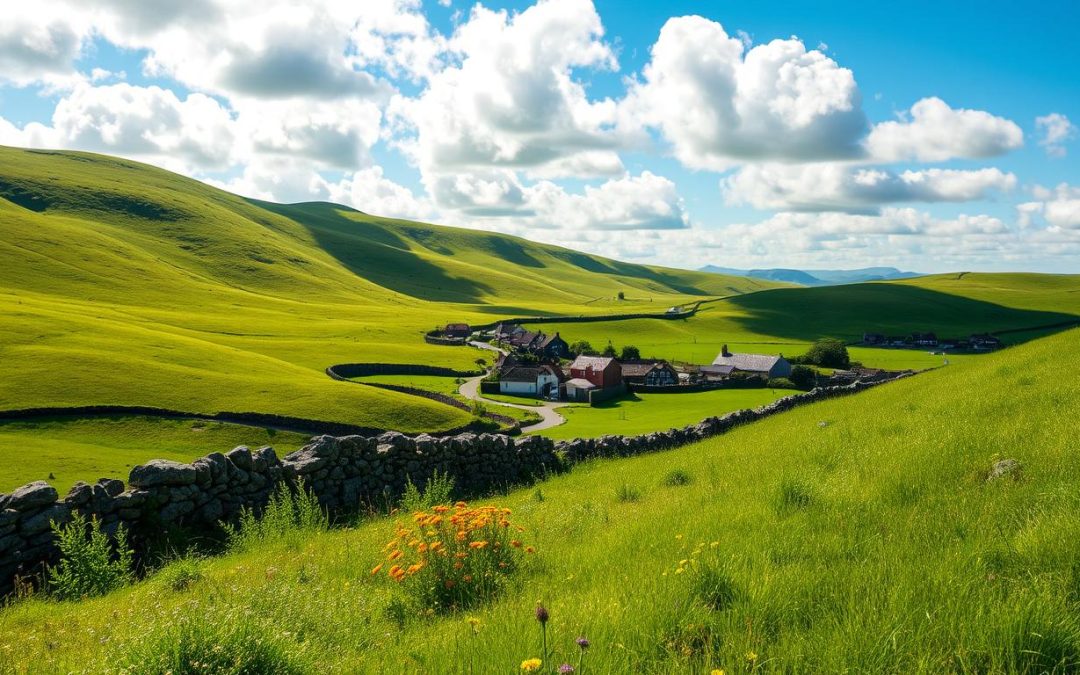Have you ever wondered how a country can balance two languages while preserving its cultural heritage? In Ireland, this duality is a fascinating reality. The island is home to both Irish and English, each with deep historical roots and modern-day significance.
Irish, also known as Gaelic, is one of the oldest written languages in the world. Its origins trace back to ancient Ogham inscriptions, offering a glimpse into Ireland’s rich past. Over time, English became more prevalent due to historical and educational influences. Today, both languages coexist, shaping the nation’s identity.
From bilingual road signs to legal recognitions, the presence of these languages is woven into daily life. Whether you’re exploring the bustling streets of Dublin or the serene Gaeltacht regions, you’ll encounter this unique linguistic tapestry. So, how does Ireland maintain this balance, and what does it mean for its people?
Key Takeaways
- Irish and English are both officially recognized in Ireland.
- Irish is one of the oldest written languages globally.
- English became dominant due to historical and educational factors.
- Bilingual road signs highlight the coexistence of both languages.
- The linguistic landscape reflects Ireland’s cultural heritage.
Ireland’s Diverse Linguistic Tapestry
Exploring Ireland’s languages reveals a rich tapestry of history and diversity. From ancient dialects to modern tongues, the country’s linguistic landscape is a vibrant mix of tradition and modernity. This section dives into the variety of languages and dialects, as well as the regional variations that make this place unique.
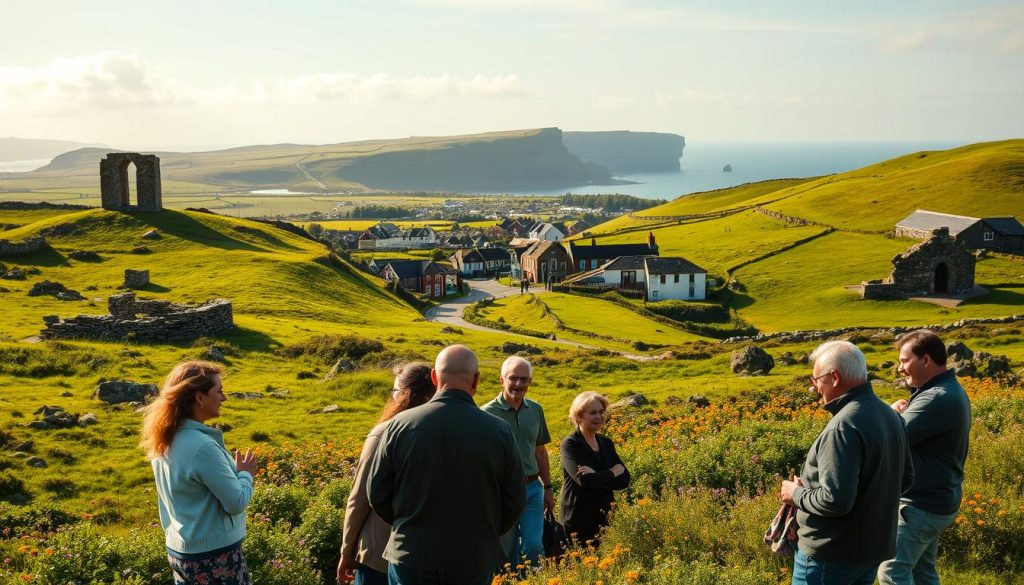
Overview of Spoken Languages and Dialects
In Ireland, the official language status is shared by Irish and English. Irish, also known as Gaelic, is deeply rooted in the country’s heritage. It’s one of the oldest written languages in the world, with origins tracing back centuries. English, on the other hand, became dominant due to historical influences and is now the primary language for most people.
Beyond these, you’ll find a variety of dialects and minority languages. Ulster Scots and Shelta are notable examples, each with its own historical significance. These dialects add layers to the linguistic richness of the country.
Multilingual Communities and Regional Variations
Ireland’s linguistic diversity extends to its multicultural communities. Urban centers like Dublin are home to immigrant languages such as Polish and Lithuanian. These languages contribute to the country’s dynamic cultural fabric.
Regional variations also play a significant role. In the Gaeltacht areas, Irish is the primary language, preserving its use in daily life. Meanwhile, other regions showcase unique dialects that reflect local history and traditions.
| Language/Dialect | Region/Community | Significance |
|---|---|---|
| Irish (Gaelic) | Gaeltacht areas | Preserves cultural heritage |
| English | Nationwide | Primary language for communication |
| Ulster Scots | Northern regions | Historical minority language |
| Polish | Urban centers | Immigrant language, growing influence |
This blend of languages and dialects makes Ireland a fascinating place for anyone interested in linguistic diversity. Whether you’re in a bustling city or a quiet rural area, you’ll encounter a unique mix of tongues that tell the story of this vibrant nation.
Historical Roots of Ireland’s Languages
Delving into the past, you’ll uncover the fascinating origins of Irish linguistic heritage. The story begins with ancient scripts and evolves into the modern forms you see today. This journey reveals how centuries of change shaped the way people speak Irish and other dialects.
Prehistoric Inscriptions and the Ogham Alphabet
The earliest traces of Irish language date back to the Ogham script, used around the fourth century. This ancient alphabet, carved into stone, marks the first recorded use of the language on the island. It’s a testament to the deep roots of Irish linguistic identity.
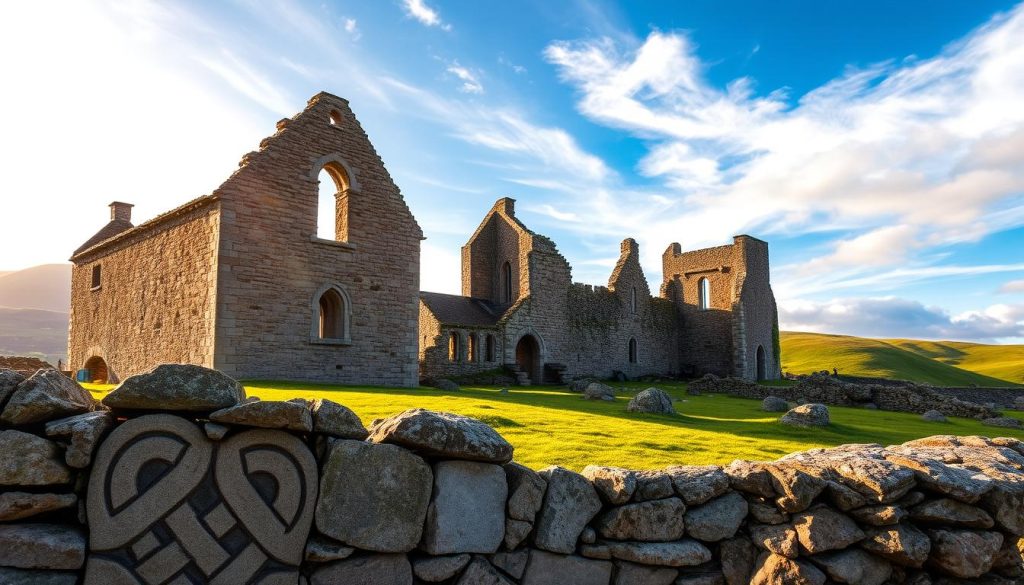
Ogham inscriptions were primarily used for memorials and boundary markers. They provide a glimpse into the lives and culture of early Irish speakers. Over time, this script laid the foundation for the development of more complex written forms.
Evolution from Old Irish to Middle and Modern Irish
By the fifth century, Old Irish emerged as a distinct language. It was used in religious texts and poetry, reflecting the cultural importance of the time. Over the next few centuries, it evolved into Middle Irish, which was spoken during the medieval period.
Modern Irish, as you know it today, began to take shape in the 13th century. This evolution was influenced by historical events and interactions with other cultures. Despite challenges, the language has survived and continues to thrive, especially in gaeltacht regions.
Understanding this evolution helps you appreciate the resilience of Irish linguistic heritage. From ancient inscriptions to modern dialects, the journey of the Irish language is a testament to its enduring significance.
The Gaelic Revival and Cultural Resurgence
The Gaelic Revival breathed new life into a language that once faced decline. This movement, rooted in passion and pride, aimed to restore Irish as a vibrant part of daily life. It wasn’t just about preserving an old tradition—it was about reconnecting with a cultural identity that had been overshadowed for centuries.
Significance of Gaeltacht Areas
Gaeltacht regions are the heart of Irish language preservation. These areas, scattered across the country, serve as living examples of how Irish thrives in communities. From schools to local businesses, the language is woven into everyday life, ensuring its survival for future generations.
In these regions, you’ll find festivals, storytelling sessions, and cultural events that celebrate Irish heritage. These activities not only keep the language alive but also foster a sense of pride among speakers. The Gaeltacht is a testament to the resilience of Irish culture.
Role of Media and Education in Promoting Irish
Media and education have played pivotal roles in the Gaelic Revival. Channels like TG4 broadcast daily content in Irish, making the language accessible to a wider audience. This exposure helps normalize its use in modern contexts.
In schools, Irish is a required subject, ensuring that every child learns the language. Educational programs in Gaeltacht areas go a step further, immersing students in Irish from an early age. This dual approach—media and education—has been instrumental in revitalizing the language.
| Initiative | Impact |
|---|---|
| TG4 Media Channel | Provides daily Irish-language content |
| Irish-Language Schools | Ensures early immersion in Gaeltacht areas |
| Cultural Festivals | Celebrates Irish heritage and language |
The Gaelic Revival is more than a historical event—it’s a living movement. Through media, education, and community efforts, Irish continues to thrive, proving that even an old language can find new life in a modern world.
The Ascendancy of English and Hiberno-English
The story of English in Ireland is a tale of transformation and cultural blending. From its early introduction to its current dominance, the language has shaped the island’s identity in profound ways. Today, English is the primary mode of communication, but its unique form, Hiberno-English, carries echoes of the celtic language and local traditions.
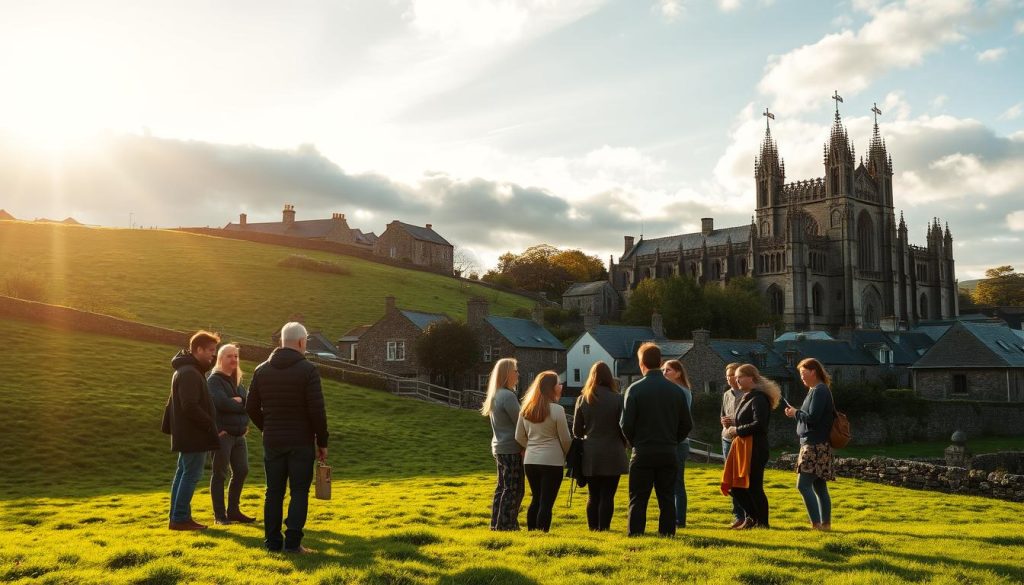
Early Introduction and Spread Through History
English first arrived in Ireland during the Norman invasion in 1169. At that time, it was a minority language, spoken mainly by settlers. Over the centuries, its influence grew, especially during the Tudor conquest in the late 16th century. By the 19th century, English became essential for social mobility and economic advancement.
The Great Famine (1845–1852) marked a turning point. Mass emigration led to a sharp decline in irish spoken communities. English became the dominant language, particularly in urban centers. Despite efforts to revive Irish, English remained the primary language for communication.
Characteristics of Hiberno-English in Daily Life
Hiberno-English, the unique variety of English spoken in Ireland, reflects the island’s linguistic heritage. It blends English grammar with Gaelic influences, creating a distinct dialect. For example, phrases like “I’m after eating” mirror Irish sentence structures.
Pronunciation and slang also set Hiberno-English apart. Words like “craic” (fun) and “yoke” (thing) are commonly used. These features highlight the interplay between traditional Irish speech and modern English usage.
| Feature | Example | Influence |
|---|---|---|
| Grammar | “I’m after eating” | Gaelic sentence structure |
| Vocabulary | “Craic” (fun) | Irish slang |
| Pronunciation | Soft “th” sounds | Regional accents |
In schools, students learn both English and Irish, but Hiberno-English dominates everyday conversations. This dynamic relationship between the two languages continues to shape Ireland’s linguistic landscape.
Ireland: Official and widely spoken languages
In Ireland, bilingualism is more than a policy—it’s a way of life. From road signs to government documents, the presence of both Irish and English is deeply woven into the fabric of society. This dual-language approach reflects the country’s commitment to preserving its culture while embracing modern communication needs.
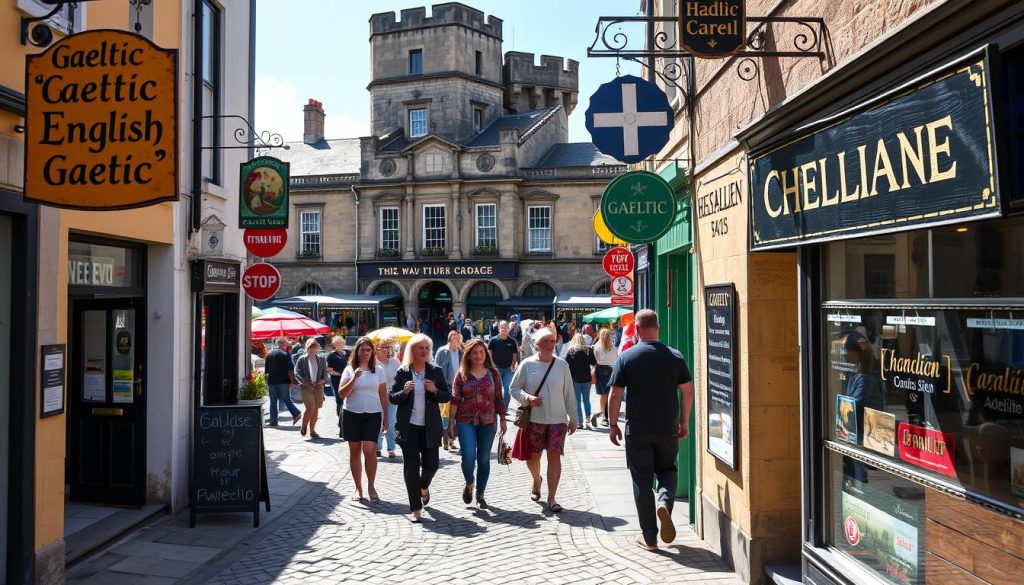
Bilingual Signage and Legal Recognition
One of the most visible examples of bilingualism is the widespread use of dual-language road signs. These signs, featuring both Irish and English, are a constant reminder of the country’s linguistic heritage. They also serve a practical purpose, ensuring clarity for locals and visitors alike.
Legally, the Constitution of Ireland grants official status to both languages. This recognition ensures that Irish remains a first language in certain regions, while English dominates nationwide. Specific legislative acts, such as the Official Languages Act, mandate the use of both languages in government communications.
Practical Use in Government and Society
In government, bilingualism is more than a formality—it’s a functional necessity. Official documents, including laws and public notices, are published in both languages. This practice ensures accessibility and inclusivity for all citizens.
Education also plays a key role. Irish is a mandatory subject in schools, fostering fluency from an early age. In Gaeltacht regions, where Irish is the first language, students are immersed in the language throughout their education.
Beyond governance and education, bilingualism enriches daily life. From cultural festivals to media broadcasts, the integration of both languages highlights the vibrant culture of Ireland. This dual-language approach not only preserves tradition but also enhances the experience for visitors and residents alike.
Immigration and the Expansion of Ireland’s Language Spectrum
The linguistic landscape of this isle has been reshaped by waves of immigration, bringing a vibrant mix of voices. From bustling cities to quiet coastal towns, the arrival of new communities has introduced a rich tapestry of languages. This transformation reflects the global influences shaping the nation’s identity.
Rise of Multilingualism in Urban Centers
Urban areas like Dublin have become melting pots of cultures. Recent census data reveals over 182 languages spoken in homes across the country. This diversity is most visible in cities, where immigrant communities thrive alongside local traditions.
Polish, French, and Arabic are among the most popular foreign languages. These tongues are not just spoken at home but also integrated into schools, workplaces, and public spaces. This blending of languages enriches the cultural fabric of the isle.
Popular Foreign Languages and Community Influence
Immigrant communities bring more than just their native tongues—they also introduce new customs and traditions. For example, Polish festivals and Arabic cultural events are now common in urban centers. These gatherings foster a sense of belonging while celebrating diversity.
Schools play a key role in this integration. Many institutions offer language programs to help students learn both Irish and English, as well as other global languages. This approach ensures that the next generation is fluent in multiple tongues.
| Language | Community | Influence |
|---|---|---|
| Polish | Urban centers | Cultural festivals, schools |
| French | Coastal regions | Business, tourism |
| Arabic | Diverse neighborhoods | Cultural events, media |
This linguistic expansion is not just a local phenomenon—it’s a reflection of the interconnected world we live in. By embracing these changes, the isle continues to evolve, offering a unique way of life that celebrates diversity and unity.
Impact of Language on Irish Identity and Modern Culture
Language is the heartbeat of a nation, shaping its identity and cultural expressions. In this land, the blend of traditional and modern influences creates a unique tapestry. From ancient irish gaelic to contemporary dialects, every word tells a story of resilience and evolution.
Music, dance, and literature are powerful reflections of this linguistic heritage. Traditional songs in irish gaelic connect listeners to centuries-old traditions. At the same time, modern artists blend these roots with global influences, creating a sound that’s both familiar and fresh.
Integration of Traditional and New Language Influences
Dialects play a key role in this cultural mosaic. Each county has its own way of speaking, adding depth to the shared heritage. For example, the soft lilt of Connemara differs from the sharper tones of Donegal. These variations enrich the national identity, making it diverse yet unified.
Immigration has also expanded the linguistic spectrum. In urban centers, you’ll hear Polish, French, and Arabic alongside irish gaelic and English. This multilingualism reflects the nation’s openness to global influences while preserving its roots.
“Language is the road map of a culture. It tells you where its people come from and where they are going.”
Education and media are vital in this integration. Schools teach both traditional and modern languages, ensuring fluency across generations. Media platforms broadcast content in multiple tongues, celebrating the nation’s diversity.
This balance between tradition and modernity defines the cultural identity. Whether through a traditional sean-nós song or a contemporary bilingual poem, the language continues to evolve, shaping the future while honoring the past.
Conclusion
The blend of tradition and modernity in language shapes a nation’s identity. From ancient scripts to modern dialects, the linguistic journey reflects resilience and adaptation. The state’s bilingual policies ensure that both gaeilge and English thrive in daily life, education, and governance.
Immigration has expanded the linguistic spectrum, introducing global influences while preserving local heritage. In regions like ulster, dialects such as scot add depth to the cultural mosaic. This dynamic interplay enriches the nation’s identity, blending old and new seamlessly.
Explore this unique linguistic heritage further. Whether through festivals, media, or education, the story of language continues to evolve, offering a vibrant way of life that celebrates diversity and unity.
The above is subject to change.
Check back often to TRAVEL.COM for the latest travel tips and deals.
Here are some Tours & Sightseeing suggestions that might pique your interests!
